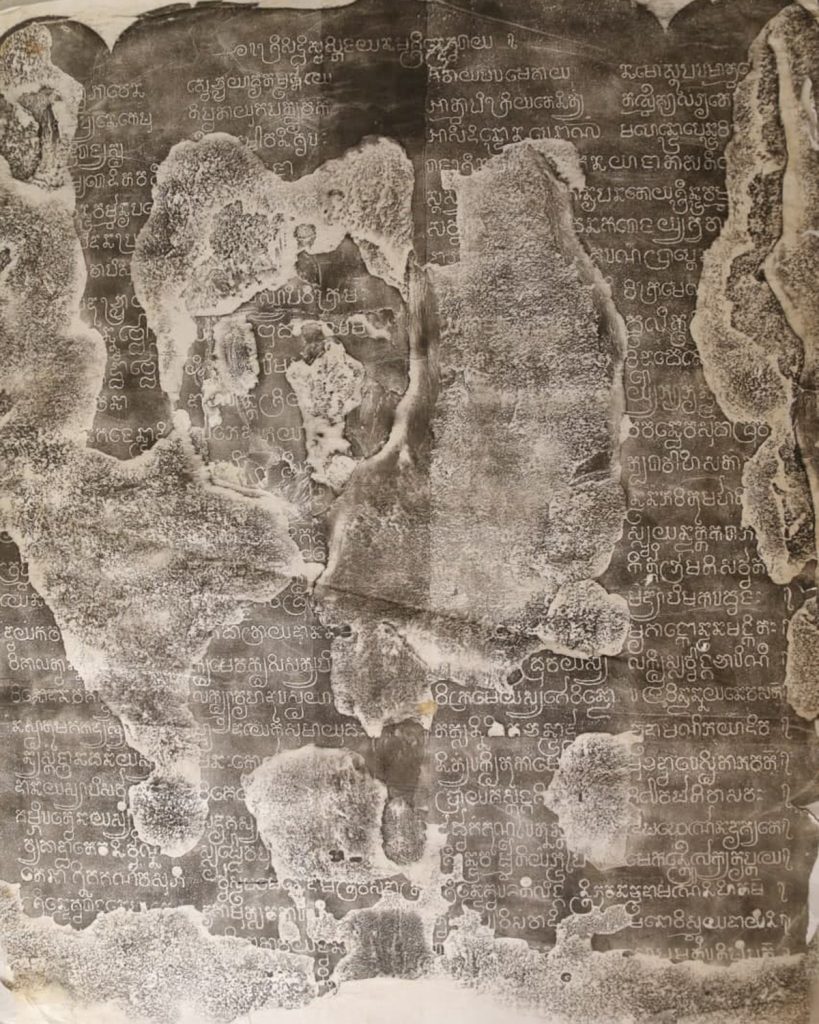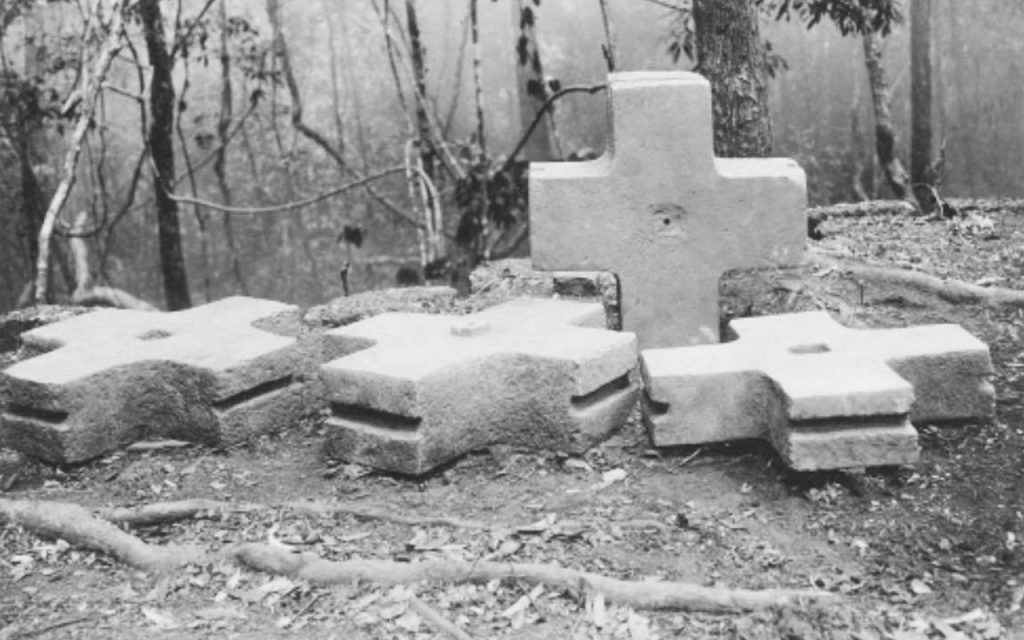
អឞ្តមូត៌ិ មានន័យថា “ការបង្ហាញទម្រង់ទាំងប្រាំបីរបស់ព្រះឥសូរ” ដ្បិត ពាក្យ “អឞ្ត” ប្រែថា ៨ និង “មូត៌ិ” ប្រែថា ការបង្ហាញ។ ទម្រង់នេះបង្ហាញអំពីគុណលក្ខណៈទាំងប្រាំបីយ៉ាងរបស់ព្រះឥសូរ ដែលរួមមាន ឝវ៌ ( Śarva) ដី (អ្នកបំផ្លាញ), ភវ (Bhava) ទឹក (ការបង្កើត), រុទ្រ (Rudra) ភ្លើង (អ្នកបណ្តេញអំពើអាក្រក់), ឧគ្រ (Ugra) ខ្យល់ (កាចសាហាវ) , ភីម (Bhīma) លំហ (អស្ចារ្យ), បឝុបតិ (Paśupati) ព្រលឹង (ម្ចាស់នៃលោក), ឦឝាន (Īśāna) ព្រះអាទិត្យ (លោកបាល) និងមហាទេវ (Mahādeva) ព្រះច័ន្ទ (ដែលជាធំ)។ នៅស្រុកឥណ្ឌាដែលជាទីតាំងរីកដុះដាលនៃសាសនាព្រាហ្មណ៍ គេកម្រឃើញមានបដិមានិងរូបចម្លាក់តំណាងឱ្យអឞ្តមូត៌ិណាស់ ពោល គឺមានតិចតួចបំផុត។ យោងតាមឯកសាររបស់លោក Deglurkar, G.B. រៀបរាប់ឱ្យដឹងថា កាលពីខែកក្កដា ឆ្នាំ១៩៧៤ នាយកដ្ឋានប្រវត្តិសាស្រ្តវប្បធម៌និងបុរាណវិទ្យានៃសាកលវិទ្យាល័យ Nagpur បានធ្វើកំណាយនៅភូមិមន្ថល (Mandhal) រកឃើញរូបបដិមាចំនួន ៣ ដែលមានមួយក្នុងចំណោមនោះមានរូបធ្វើអំពីថ្មភក់ទំហំ ២៥ x ១៧ x ៩ ស.ម. មានព្រះហស្តពីរនិងព្រះសិរប្រាំបី មានអាយុកាលរវាងស.វ.ទី៣-៥ ដែលគេសន្និដ្ឋានថាគឺជារូបព្រះសិវក្នុងទម្រង់ជា “អឞ្តមូត៌ិ”។ សម័យក្រោយមក គេកម្រឃើញមានចម្លាក់ឬបដិមានៅក្នុងស្រុកឥណ្ឌាឆ្លាក់បង្ហាញរូបអឞ្តមូត៌ិណាស់។
ដោយឡែក នៅក្នុងអារ្យធម៌ខ្មែរវិញ ពាក្យ “អឞ្តមូត៌ិ” លេចឡើងដំបូងនៅក្នុងសិលាចារឹកប្រាសាទបាគង (K.826) រាជ្យព្រះឥន្រ្ទវរ្ម័នទី១ ស.វ.ទី៩ គាថាទី២៥ ដែលរៀបរាប់ថា៖
“ឥលានិលាគ្និចន្រ្ទាក៌្ក សលិលាកាឝយជ្វនះ
រាជវ្ឬត្កិវិតេឝស្យ សោឞ្តមូត៌ិឞ្ឋិបត”។
ប្រែថា៖
“ព្រះអង្គទ្រង់បានប្រតិស្ថានព្រះបដិមាអស្តមូត៌ិរបស់ព្រះឦឝ តាមព្រះរាជ
ប្រវេណី និងតាមទម្រង់ផែនពសុធា ខ្យល់ ភ្លើង ព្រះចន្រ្ទ ព្រះអាទិត្យ ទឹក
អាកាស និងការបូជាយញ្ញ” ។
តាមទិន្នន័យសិលាចារឹកនេះ គេពុំដឹងប្រាកដថាព្រះបដិមាអឞ្តមូត៌ិនៅប្រាសាទបាគងនេះជារូបអ្វីឱ្យប្រាកដឡើយ តែគេគ្រាន់សន្និដ្ឋានចំនួនប្រាំបីអាចសំដៅទៅលើប្រាង្គទាំងប្រាំបីនៅក្នុងកំពែងទី១របស់ប្រាសាទបាគងដែលសុទ្ធសឹងជាតួប៉មធ្វើអំពីឥដ្ឋ។

ក្រោយមកទៀត គេតែងប្រទះឃើញពាក្យនេះនៅក្នុងសិលាចារឹកមួយចំនួនក្នុងស.វ.ទី១០ ជាពិសេសសិលាចារឹកក្នុងរជ្ជកាលព្រះបាទរាជេន្រ្ទវរ្ម័ន (គ.ស.៩៤៤-៩៦៧)។ ជាក់ស្តែងនៅក្នុងសិលាចារឹកប្រាសាទនាគបួស (K.580) រៀបរាប់ថា “ព្រះបាទស្រីរាជេន្រ្ទវរ័្មន បានបង្គាប់ឱ្យស្តេងអញព្រះគ្រូបញ្ជាដល់មន្រ្តីឱ្យស្ថាបនាព្រះកម្រតេងអញអឞ្តមូត៌ិ្តនៅស្រុកស្វយម្ភុបុរ និងបានថ្វាយខ្ញុំបម្រើព្រះ” ។ ករណីសិលាចារឹកប្រាសាទនាគបួសនេះដូចប្រាសាទបាគងដែរ គឺយើងមិនអាចដឹងបានថាតើព្រះឥសូរក្នុងទម្រង់អឞ្តមូត៌ិដែលបានរៀបរាប់នេះ សិល្បករបង្ហាញជារូបភាពបែបណាឡើយ។
ងាកថយក្រោយបន្តិចទៅមើលរជ្ជកាលព្រះបាទជ័យវរ្ម័នទី២ (គ.ស.៧៧០-៨៣៤) វិញ តាមការស្រាវជ្រាវផ្នែកបុរាណវិទ្យាគេធ្លាប់រកឃើញថ្មបញ្ចុះចំនួន៨ដុំ មានរាងកាកបាទបញ្ចុះនៅក្នុងគ្រឹះប្រាសាទអារាមរោងចិន ដែលស្ថិតនៅលើភ្នំគូលែន ខេត្តសៀមរាប និងមានអាយុកាលនៅស.វ.ទី៩។ ថ្មបញ្ចុះរាងកាកបាទនេះ លោក Bruno BRUGUIER, Jean-Baptiste CHEVANCE, Olivier CUNIN យល់ថាជាការបង្ហាញទម្រង់ទាំង៨របស់ព្រះឥសូរ (អឞ្តមូត៌ិ) ហើយគំនិតនេះបានយល់ស្របដោយកញ្ញា ងួន ចាន់ដារីយ៉ា ដ្បិតកញ្ញាយល់ថាថ្មបញ្ចុះនេះមានចំនួន៨ដុំ ដាក់ភ្ជាប់គ្នាជាប្រាំបីថ្នាក់ តាំងពីគ្រឹះក្រោមរហូតដល់បាតសិវលិង្គ។

សរុបសេចក្តីមក យើងបានដឹងច្បាស់ថាសិល្បករខ្មែរបុរាណបានស្គាល់ច្បាស់អំពីគំនិតនៃអឞ្តមូត៌ិរបស់ព្រាហ្មណ៍សាសនានៅសម័យអង្គរ។ ទោះបីជាយ៉ាងណា យើងពុំដឹងថានៅសម័យមុនអង្គរ តើគេប្រើប្រាស់គំនិតនេះដែរឬអត់ទេ ដ្បិតសិលាចារឹកសម័យមុនអង្គរពុំឃើញមានរៀបរាប់អំពីពាក្យនេះឡើយ។ ប៉ុន្តែ បើយើងគិតអំពីសំណង់ដែលមានរាងប្រាំបីជ្រុងវិញ យើងឃើញមានច្រើនណាស់នៅស.វ.ទី៧ ពោល គឺនៅតំបន់ប្រាសាទសំបូរព្រៃគុកដែលមានរហូតដល់ ១៥តួប៉ម និងជាពិសេសទៀតនោះនៅខាងមុខតួប៉ម N7 នៃក្រុមខាងជើងយើងឃើញមានជើងទម្រមួយរាងប្រាំបីជ្រុងថែមទៀតផង។ ក្រៅពីសំណង់ប្រាសាទនិងជើងទម្រ យើងក៏ដឹងច្បាស់ថានៅតំបន់ប្រាសាទសំបូរព្រៃគុកមានជំនឿទៅលើព្រះឥសូរមុតមាំណាស់៕

————————————————————-
Aṣṭamŭrti
Aṣṭamŭrti means “manifestation of the eight forms of Shiva”, while the word “Aṣṭa” means eight and “Mŭrti” means manifestation. This form shows the eight attributes of Shiva, including Śarva (destroyer), Bhava (creation), Rudra (dispeller of sorrows), Ugra (fearsome), Bhīma (great), Paśupati (lord of all beings), Īśāna (directional ruler), and Mahādeva (Supreme).
India is a flourishing place of Brahmanism, there is a statue rarely to represent Aṣṭamŭrti. According to the documents of Deglurkar, G.B. It depicted that in July 1974, the Department of History of Culture, and Archeology of Nagpur University excavated in Mandhal village and found three statues, one of which was made of sandstone, measuring 25 x 17 x 9 cm Two hands and eight heads, dating to the 3rd and 5th centuries, are assumed to be Siva statues in the form of “Aṣṭamŭrti”. In later times, it was rare to find sculptures or statues in India indicating Aṣṭamŭrti.
Whereas, in Khmer civilization, the word “Aṣṭamŭrti” first appeared in the inscriptions of Prasat Bakong (K.826), the reign of Indravarman I, 9th century AD. According to the inscription data, it is not known for sure what the statue of Aṣṭamŭrti at Bakong Temple is, but it was only concluded that the eight numbers can be drawn about the eight shrines in the first tier of Bakong Temple is made of brick.
Later, this word is often found in some inscriptions in the 10th century, especially the inscription of Prasat NAg Pous (K.580), which states “King Srei Rajendravarman ordered to appoint SteN An, Preah Krou, to the officials to build a Preah KaMmratAN Aṣṭamŭrti in Sruk Svayambhu, and offering a servant of God.” In the case of the NAG Pous inscription, like the Bakong temple, we do not know what kind of Siva image is in the form of Aṣṭamŭrti. Looking back at the reign of Jayavarman II (770-834), archaeological excavations have uncovered eight pieces of cross-shaped stone buried in the foundations of the Rong Chen temple at Phnom Kulen, Siem Reap province and dating to the 9th century. This cross-shaped stone, Bruno BRUGUIER, Jean-Baptiste CHEVANCE, Olivier CUNIN, sees it as a manifestation of the eight forms of Siva (Aṣṭamŭrti), and this idea was agreed upon by Mss. Nguon Chandariya, as she understood that the eight pieces of cross-shaped stone are connected in eight levels from the foundation to the support of Linga.
In conclusion, we know very well that the ancient Khmer artists were well aware of the concept of Aṣṭamŭrti of Brahmanism in the Angkorian period. However, we do not know whether this concept was used in pre-Angkorian or not, because the pre-Angkorian inscriptions do not mention the word “Aṣṭamŭrti”. However, if we think about the octagonal structure, we see a lot of it in the 7th century, that is, in the complex of Sambor Prei Kuk temple with up to 15 towers, and especially an octagonal pedestal in front of the N7 tower of the north group. In addition to the construction of temples and pedestals, we also know that in the region of Sambor Prei Kuk, there is a strong belief in the Siva.
អត្ថបទដើម៖ លោក ម៉ង់ វ៉ាលី






